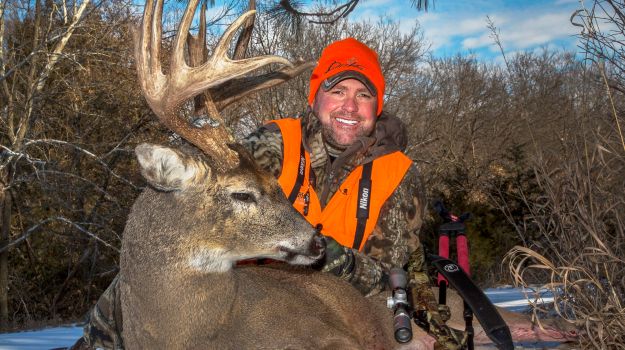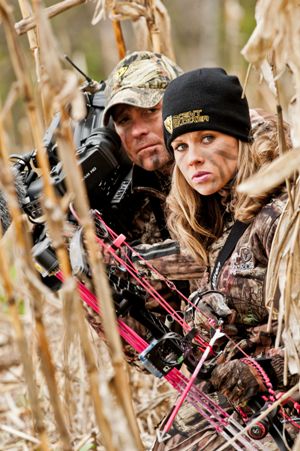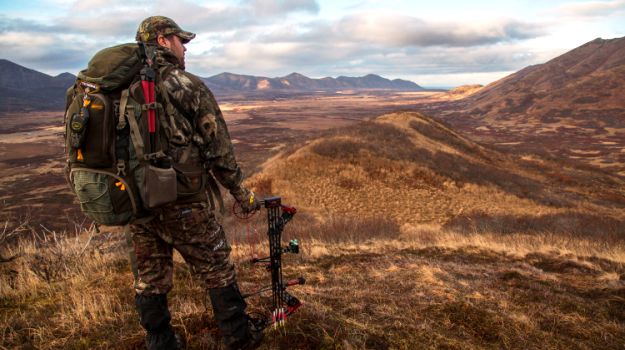
Editor’s Note: Mossy Oak pros Pat Reeve and his wife Nicole have hosted “Driven with Pat and Nicole,” a TV show on the Outdoor Channel for the past 10 seasons. The biggest news from Pat and Nicole is that during the 2014-2015 season Nicole was with child.
In 2014, Nicole and I both drew Iowa late season muzzleloader whitetail deer tags for the southeastern zone of the state. We hunted out of Wingover Ranch, an area we’d hunted the previous year during the late muzzleloader season. I was fortunate enough then to take a whitetail buck that scored 180 points Boone & Crockett.
When we arrived at camp, the weather was perfect for a late season hunt with snow on the ground, and the air crisp and cold. We realized that hunting over food sources would be the key to success to prevent putting pressure on the deer. To ensure our chances would be best for taking an older-age-class buck, we decided not to hunt during the morning hours but rather limit . our hunting to afternoons only. In the afternoon, the deer should migrate out of the woods and come out into the fields to feed. We knew we’d be sitting in ground blinds, which would give us some protection from the weather and plenty of room to move around and film.
In 2013, I had seen the sheds of a really-big buck there and was hunting him. But the buck was so nocturnal he didn’t show up. Of course, when I took the 180 point buck in 2013, I wasn’t disappointed. This year I wanted to see if I could take the buck that I didn’t see in 2013. We knew this buck more than likely would be nocturnal in 2014 - just like he'd been in 2013. However, there was one secluded green field that was rarely if ever hunted. Soybeans were standing in this food plot, and turnips were planted there. This 5-acre food plot was nestled in a creek bottom where several ridges came together, and the deer could come off the ridges and feed in this bottom.
 When we began our hunt, the temperature was about 15 degrees, and fresh snow was on the ground. We knew the weather was cold enough for the deer to be on their feet and moving before dark. Although the outfitter didn’t have any trail-camera pictures of this buck in this field since November, he felt we might have a good chance to take him. All the conditions were right, and the buck had fed in this field during the early season. Because the field was so secluded, and there was still plenty of food in the field, we should have a better-than-average chance of seeing this buck. Since we had a favorable wind, we moved quietly to get into the blind 4 hours before dark. For 3 hours, we sat in the blind, and we didn’t see a deer. But then about an hour before dark, a fawn came out into the field, followed by a spike buck, next by a somewhat bigger buck, then an even bigger buck and finally the monster buck stepped out.
When we began our hunt, the temperature was about 15 degrees, and fresh snow was on the ground. We knew the weather was cold enough for the deer to be on their feet and moving before dark. Although the outfitter didn’t have any trail-camera pictures of this buck in this field since November, he felt we might have a good chance to take him. All the conditions were right, and the buck had fed in this field during the early season. Because the field was so secluded, and there was still plenty of food in the field, we should have a better-than-average chance of seeing this buck. Since we had a favorable wind, we moved quietly to get into the blind 4 hours before dark. For 3 hours, we sat in the blind, and we didn’t see a deer. But then about an hour before dark, a fawn came out into the field, followed by a spike buck, next by a somewhat bigger buck, then an even bigger buck and finally the monster buck stepped out.
On this hunt, I was filming myself. While I was trying to watch the buck, set-up the camera and get ready to shoot, I felt like I was in the middle of a three-ring circus, trying to direct traffic, and I was the only performer. My plan was to get as much footage with the camera as I could of the buck coming into the field, and then the outfitter in the blind with me shooting the footage of me taking the deer with my .50 caliber Thompson/Center Pro Hunter muzzleloader. After I’d shot about 10 minute of footage of this big buck on the green field, I picked up my gun. I asked my outfitter, “Have you got the buck framed up?” The outfitter said. “I can’t even see the deer in the view finder.” So, I readjusted the camera and got the deer framed up.
As I sat down to get ready for the shot, I heard something. I looked up and saw a helicopter flying low, headed straight for the green field where we were hunting. The other deer were running out of the field. The buck I wanted to take already had his head up. I could tell by his body posture that he was wondering why all the other deer had left the field. I knew I had to take this shot quickly. Luckily, the buck was standing broadside to me. I sat back down in my chair, aimed quickly and fired. I made a good hit on the deer, and he started running, but he fell before he got out of the field. When I checked my camera, we had the footage of me taking the shot, the bullet hitting the deer, and the deer falling in the field. Although Nicole hunted hard that week, she didn’t see a buck she wanted to take. So I videoed myself taking a doe to finish the hunt and the video.
I guess what made this such a memorable hunt for me was the fact that the big buck wouldn’t come in, all the confusion in the blind (everything that could go wrong did go wrong), and still being able to take the buck and get the footage.
Pat Reeve Explains When a Brown Bear Hunt Is More Than a Brown Bear Hunt




























